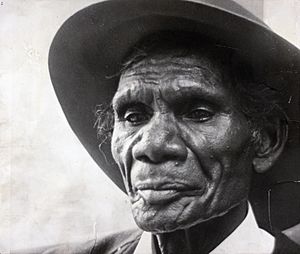Yirawala facts for kids
Yirawala (born around 1897 – died April 17, 1976) was an Aboriginal Australian leader, worker, and painter. He was born in the Northern Territory, which was then part of South Australia. He passed away in Minjilang, also known as Croker Island.
Contents
Yirawala's Early Years
Yirawala was born into the Kunwinjku community. This was at a place called Marrkolidjban, near Maningrida in Arnhem Land. We don't know much about his early life. However, he spent most of his life on Croker Island. He always kept strong ties to his family and culture. His talent for art became clear when he was very young.
A Famous Artist: The 'Picasso of Arnhem Land'
Yirawala was often called the "Picasso of Arnhem Land". This was because his art was so amazing. Even the famous artist Pablo Picasso admired Yirawala's work. He reportedly said Yirawala used space in a very special way.
In 1964, Yirawala met Sandra Le Brun Holmes. She helped him a lot with his art. She set up his first solo art show in 1971. This show traveled to many places. His bark paintings were seen in Adelaide, Melbourne, Orange, and Port Morseby.
Art dealers did not follow Yirawala's wishes. He wanted his paintings to be shown and sold in story groups. But most of the money from his art went to the dealers. His art was sold in Australia and other countries. This made Yirawala unhappy with the art business. He never knew what happened to many of his important and sacred artworks. He really did not like his art being sold just for money.
Yirawala often told funny stories. He had a great sense of humor. This helped him not to get completely upset with the art world. People remember him as a handsome and respected man. He had sharp eyes, often hidden by an old bush hat.
Teaching Other Artists
The Marrkolidjban outstation was in the Liverpool River area. It was very important for the growth of Aboriginal art. Yirawala taught and inspired other artists there. These included Curly Bardkadubba, Peter Marralwanga, and John Mawurndjul. A new generation of artists learned and improved cross-hatching techniques from him.
When Yirawala went back to Croker Island, he taught cross-hatching to artists there too. Midjau Midjau and Samual Wagbara were among them.
Yirawala was happy to mix different painting styles from various regions. This led to big changes in Aboriginal bark paintings.
Family and Legacy
Yirawala was married three times. He had seven children. We don't know much about them, except for two sons, Bobby and Danny. They lived on Croker Island. He settled with his family on Croker Island in the late 1950s. By then, he was a very important bark painter.
Yirawala was a leader in ceremonies. He was also a "law-carrier," meaning he knew and shared his people's laws. He was also a medicine man and healer. People saw Yirawala as a wise and honest man. He worked hard to keep his people's culture alive. Lazarus Lamilami said he was one of many great leaders. These leaders passed down sacred designs to future generations.
Yirawala received a special honor in 1971. He was made a Member of the Order of the British Empire (MBE). He also got the International Art Cooperation Award. After his MBE, a sculptor named John Dowie made a bronze statue of Yirawala. Yirawala believed this statue held his spirit. Yirawala died on April 17, 1976. His body was taken back to Morgaleetbah, where his father was also buried. After he died, who should own the bronze statue became a big discussion. The statue was at the Adelaide Art Gallery. But after some talks, it was given to Yirawala’s family.
The National Gallery of Australia bought 139 of his paintings in 1976. In 1982, one of his paintings was used on a 27¢ stamp. This stamp celebrated the National Gallery's 15th birthday. His artworks are in many Australian galleries and collections around the world. Two films have been made about him: Return to the Dreaming (1968) and The Picasso of Arnhem Land (1982). You can find pictures of Yirawala's bark paintings online. These are from the National Museum of Australia's collection.


